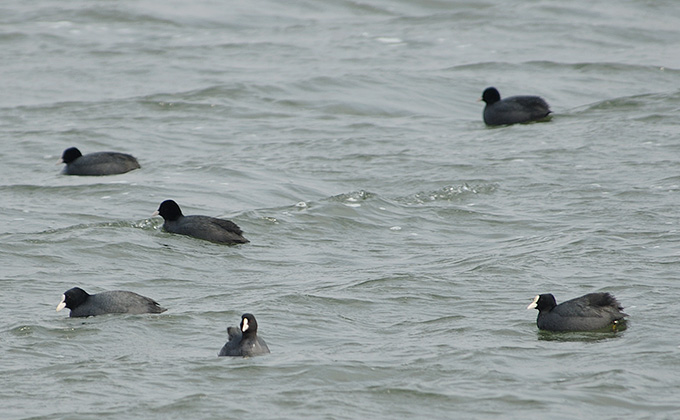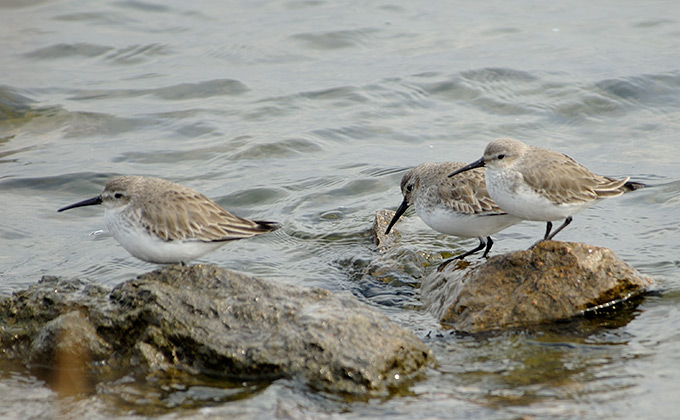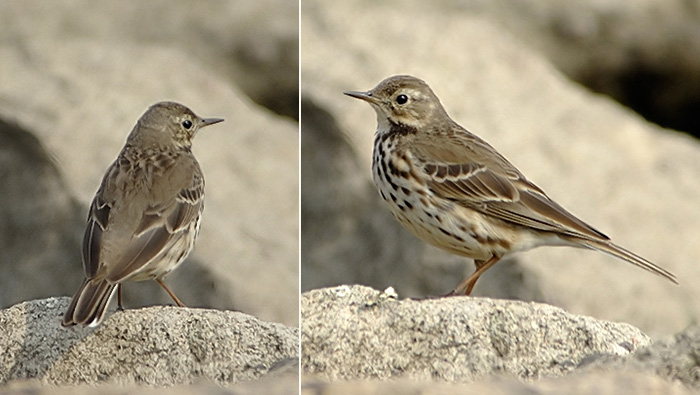 | E-mail to Birds Korea |
 | KWBS |
in the Region
 | The Oriental Bird Club |
 | BirdLife International (Asia) |
March
March often contains a mixture of dry, cold days (with night temperatures down to 3-4°C, and highs between 10 and 15°C) and occasional milder showery, windy weather.
Most wintering species are still present, but in progressively reduced numbers. Falcated Duck regularly display on reservoirs and ponds, while small numbers of Baikal Teal remain at key sites. Migrant cranes peak in the northwest, as does the Ancient Murrelet migration along the east coast. Small numbers of shorebirds, including early Great Knot arrive, plus Siberian Buff-bellied Pipits and the first leucopsis White Wagtails. Hundreds of Rustic Buntings, Dusky and Naumann's Thrushes move north-east out of China and Japan, along with smaller numbers of raptors and occasional influxes of Japanese Waxwing. Bramblings and Siskins often form large flocks at key migration points. Sunny days tempt Rustic, Meadow, and Yellow-throated Buntings into song.
>March highlights are usually found by carefully searching through gull flocks for taxa like Pallas's Gull, barabensis, cachinanns, or smithsonianus, though Korea's first Japanese Accentor was found in March 2001 in Busan, Korea's first Bar-headed Goose on the Han-Imjin in 2003, and early migrant Red-billed Starlings and a Chinese Blackbird in 2004, and in 2006 Korea's eighth Pallas's (Great Black-headed) Gull - a species that seems to be a regular (though very scarce) winter visitor.
(The following records are a compilation of our own sightings and records sent in by other observers. As well as being posted on the Birds Korea website(s), selected records are also forwarded to other Korean-language birding websites; records of threatened species are arranged and forwarded to Birdlife International and national authorities when appropriate; flag images and records are passed to bodies responsible for their coordination throughout the flyway; and all records sent to us are used to compile annual reports and to support the evolving understanding of the status of many of Korea’s birds.)
Mokpo Namhang Tidal flat, March 31
On the last day of March the tidal flat is still dominated by ducks as of which were 436 Common Teal, 57 Spot-billed Duck, 51 Mallard, 150 Eurasian Wigeon, 54 Gadwall, 44 Common Shelduck, 43 Northern Shoveler, 36 Falcated Duck. Also 31 Black-headed Gull, 22 Black-tailed Gull, 54 Common Gull, 120 Herring Gull, 25 Heuglin's Gull, 5 Yellow-legged Gull populated the place. Shorebirds are still in small numbers, only 4 Bar-tailed Godwit, 3 Great Knot, 1 Common Sandpiper, 78 Kentish Plover, 2 Little Ringed Plover could be found. Beside the 5 Grey Heron, 1 Little Egret and 2 Little Grebe the exceptional record of this tidal flat is the presence of 4 Eurasian Spoonbill, the first individual seen on March 16 and then again 3 on March 30. In the vegetation along the tidal flat 2 Black-billed Magpie, 2 Oriental Greenfinch, 4 Olive-backed Pipit, 2 Brown-eared Bulbul, 1 Hoopoe, 2 Dusky Thrush, 1 Daurian Redstart were seen.
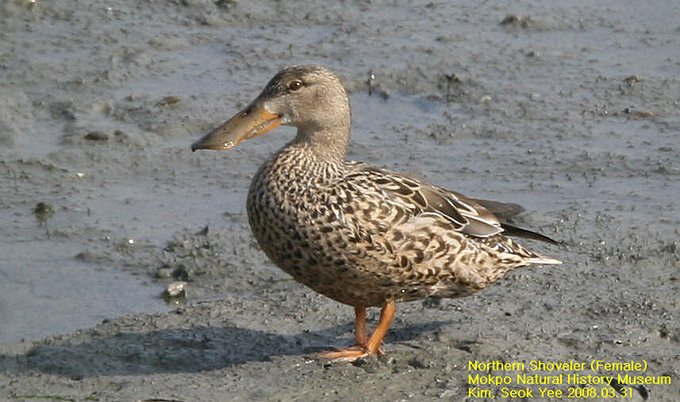
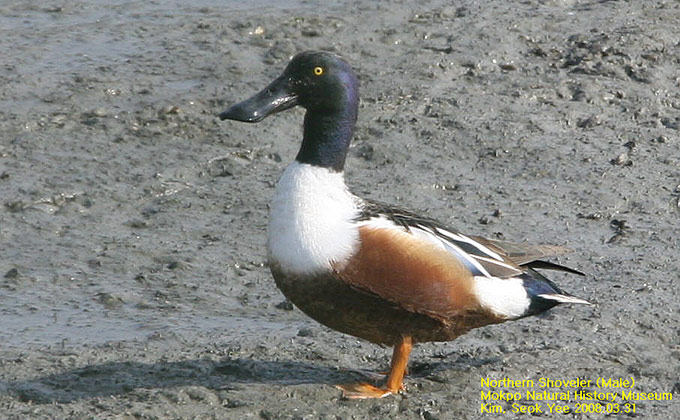
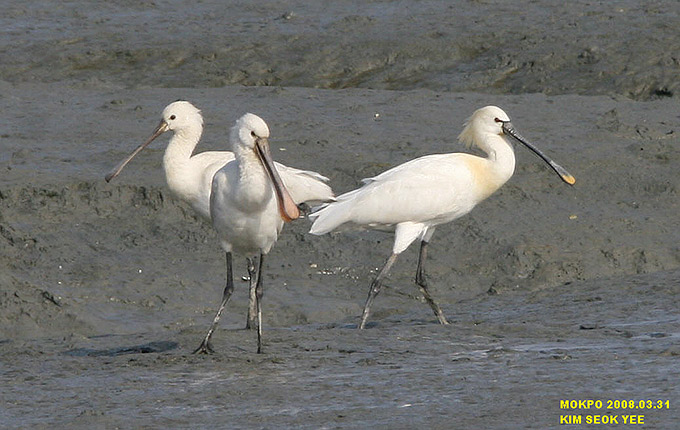
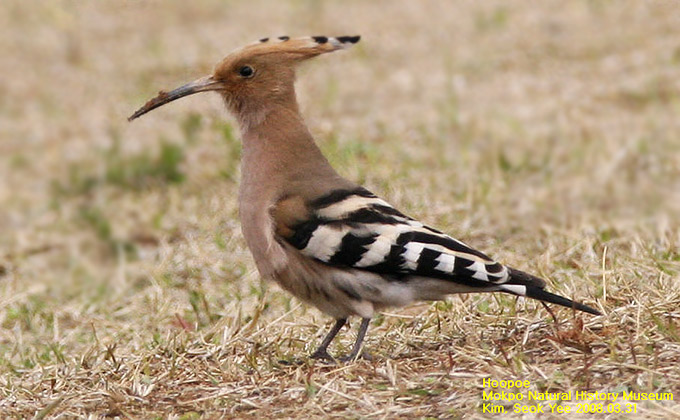
Geum Barrage, March 30
Warm weather with a slight breeze greeted us at the Barrage today. In the parking lot at the NW corner, Hawfinch were seen in trees and Grey-capped Greenfinch were seen flying over. Yellow-faced and Black-faced Buntings called from the bushes while Chinese Penduline Tits and Common Reed Buntings were spotted in the reeds next to the tidal flats.
On the flats themselves, evidence of migrants were seen through good numbers of Dunlin and 570 Bar-tailed Godwit. Smaller numbers of Eurasian and Far Eastern Curlew, Spotted Redshank and Grey Plover were also present. 2 Kentish Plover were found amid the flock, while surprises were 2 Great Knot, and single Black-tailed Godwit and Common Redshank.
DeokJeokDo, March 29-30

Great birding weekend on DeokJeokDo, with a good mix of Winter and Summer visitors crossing paths, and several surprises (cool and steady rain on Saturday, cool and cloudy on Sunday.) Super spotter Blaine Jones helped greatly. The 200-year old pine trees that line the beach were exploding with large numbers of Yellow-throated Bunting, as well as Great Tit. Long-tailed (magnus), Varied, Coal, and Marsh Tit, as well as Meadow and Rustic Bunting were also seen, in much smaller numbers. lugens White Wagtail have also seemingly taken over the island, with large groups seen in many areas.
A Bull-headed Shrike (whose white wing patch was obscured by ruffled feathers) surveyed a valley from a tree top. About 5 male, and 2 female Siberian Stonechat were active among some reeds and bushes. A flock of a dozen Chinese Grosbeak noisily flew between trees. Four Siberian Accentor, a Green Sandpiper, three Hoopoe, several Daurian Redstart, plentiful Eurasian Magpie and Brown-eared Bulbul, and several Naumann’s and Dusky Thrush were also seen on Saturday. The beach was quiet apart from a raft of about 30 Mallard and Spot-billed duck, as well as some Black-tailed Gulls. A presumed Black-crowned Night Heron was briefly seen, and heard on Saturday night.
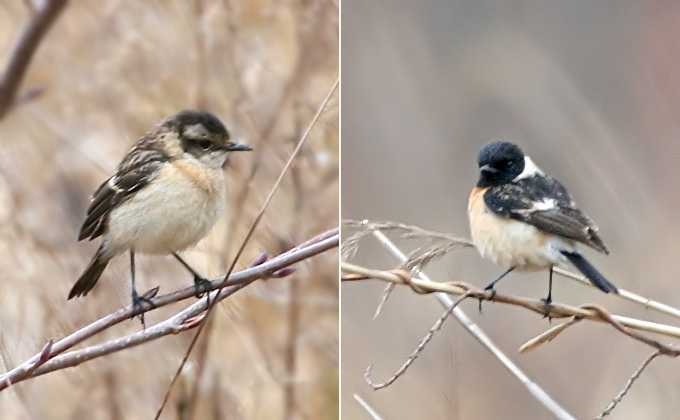
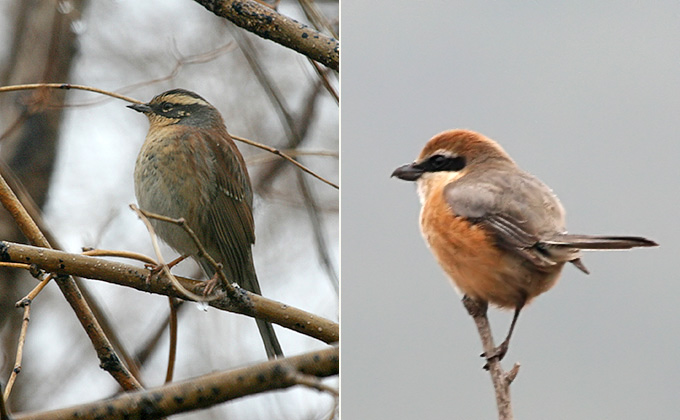
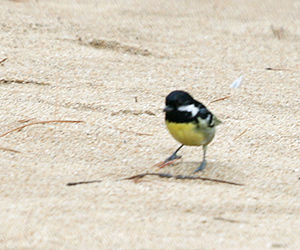
Photo © Mathew Poll
March 30: Sunday started with two mysteries – a large, unidentified brown owl was briefly seen flying between some cliffs and a narrow valley. Later on, a loud, mournful and piercing whistle was heard every 8 seconds coming from a stand of pines. Two Winter Wren, a pair of Blue Rock Thrush, a Goldcrest, a pair of Temminck’s Cormorant, a male Brambling in Summer plumage, several noisy Jays, and several Rufous Turtle Dove were seen near the beach. At least 15 female Ring-necked Pheasant conspired to repeatedly startle anyone walking on a path next to a weedy field.
A major highlight was a group of 4 Light-vented Bulbul spotted near some bamboo. Another surprise was a pair of Eastern Oystercatcher (possibly two pairs, as two were seen on opposite sides of the island within a short period of time.) The biggest surprise was a Yellow-bellied Tit (it appears to be a male in breeding plumage), which was associating with a large flock of at least 100 Great Tit. It was seen only briefly, and could not be relocated. A Grey Wagtail was seen near the ferry port. A smallish black and white bird was briefly but clearly seen through binoculars next to the moving ferry. It was flapping rapidly, very close to the water, and after consulting pictures, I’m 95% confident it was an Ancient Murrelet in Winter plumage.
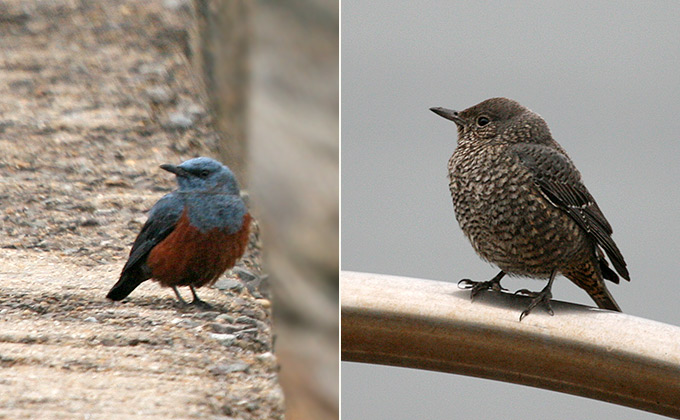
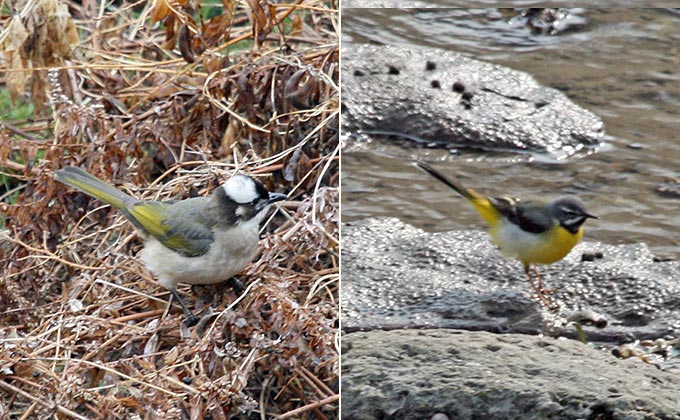
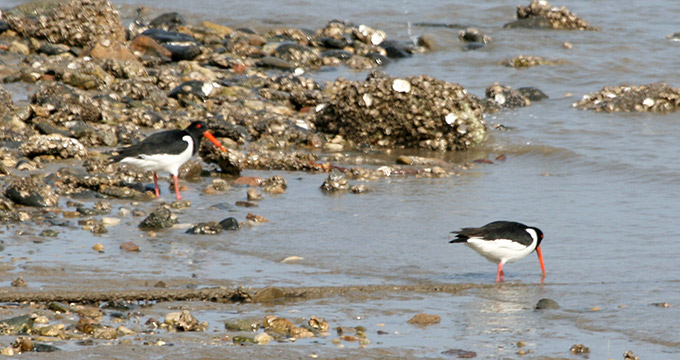
Jungnangcheon, March 29
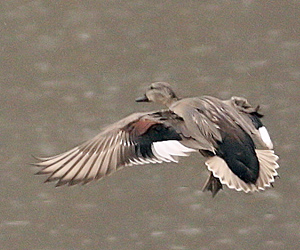
Fairly quiet on the river today, with the bulk of winter wildfowl clearly departed within the last week or so: best however 2 lingering Smew, a Mandarin and c.45 Gadwall.
On the broad Han River, several Goosander, Mongolian Gulls, & a few Great Cormorant.
Springtime Grey Herons are suddenly sporting bright orange/pink bills, a pair of Kestrels already feeding young at a nest under the bridge, and parties of leucopsis White Wagtails are in evidence.
Otherwise, still c.50 Tufted Duck, 2 Pochard, 10 Mallard, 20 Shoveler, and c.60 each of Teal and Pintail.
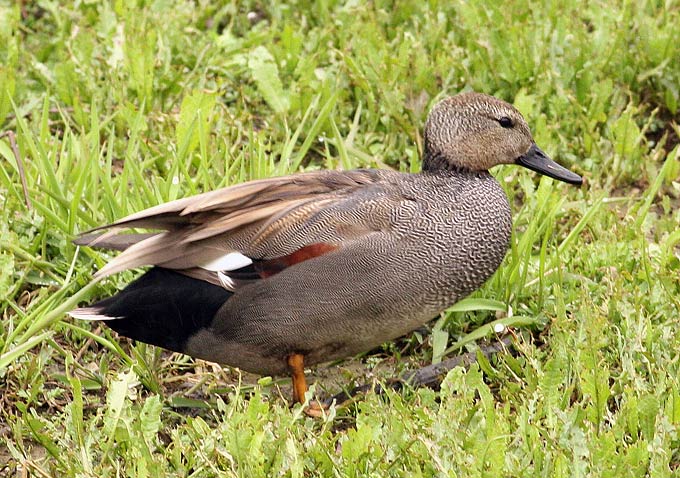
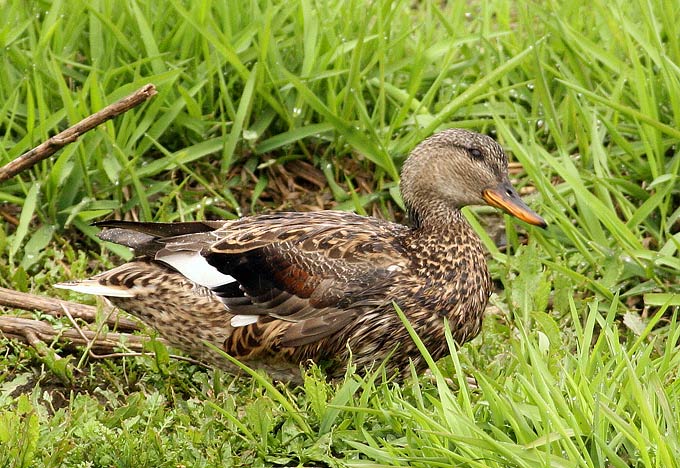
Igidae, Busan, March 25
Two hours at Igidae in spring-like weather, with sunny, slightly hazy conditions, and a mild high of 15 C or 16C. Along with the cherry blossoms, lots of fresh greenery, the occasional butterfly (including one early-on-the-wing black swallowtail species) and alot of bird activity, with for example 8 or so Varied and 3 or 4 Long-tailed Tit feeding in one yellow-flowered bush, signing Daurian Redstart, Blue Rock Thrush minor Great Tit and Yellow-throated Bunting etc nearby, and the personal first Streaked Shearwater of the spring, with probably 15 seen in 30 minutes of seawatching, along with a single Black-legged Kittiwake, tens/low hundreds of gulls moving north, and at least 63 loons (with most numerous Pacific, moving into breeding plumage, followed by Red-thoated and then Arctic Loons, the latter two species almost in complete non-breeding plumage).
Chungju, March 22, Danyang, March 23

Managed to sneak in some birding on a ‘non-birding’ trip, this rainy and warm weekend. In Chungju near the dam, the highlight on the quiet lake was a pair of Mandarin Duck, sticking close to the shore. 5 Common Merganser were also on the lake (the water level of which has dropped by about 50 feet since September - perhaps let out of the dam?), along with a Little Grebe. An unidentified buzzard circled high over a nearby mountain, while 2 Meadow Bunting fed in a lot next to a road. A vocal and bold Japanese Pygmy Woodpecker searched for food in the nearby trees. Several Daurian Redstart were loudly singing and calling. Also seen was a fast-moving brown lizard about 10 cm long (the first lizard I’ve seen in Korea). In Danyang, 4 Grey Heron, a Common Sandpiper, and a Japanese Wagtail were spotted on rocks next to the river. Later in the day in East Seoul, a light phase Daurian Jackdaw was seen perched on a light post near the bus station.
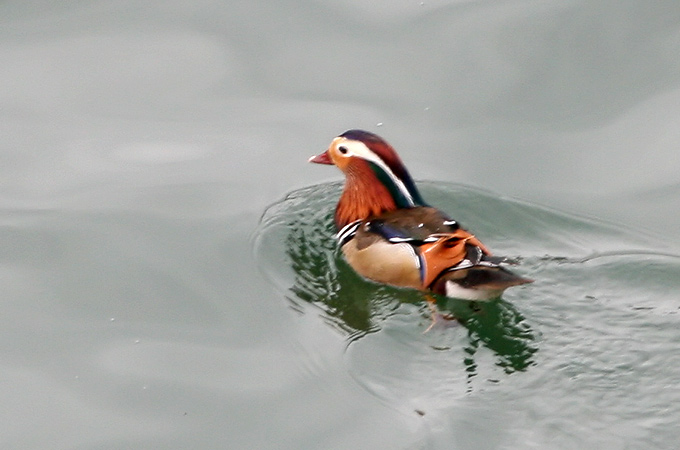
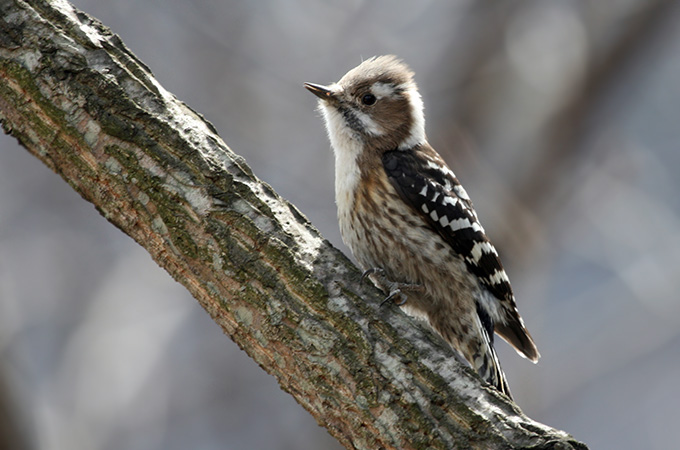
North Seoul, March 20
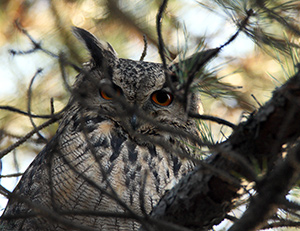
Photo © Robin Newlin
An afternoon in clear (dust free) springlike weather at various points north of Seoul.
Highlights were scattered flocks of Bean and White-fronted Geese, a few Rustic and Yellow-throated Buntings, a scolding Daurian Redstart, a scolding Wren (heard only), migrating dozen White-naped Cranes, a single Rough-legged Hawk, and no less than 3 adult Eurasian Eagle Owls.
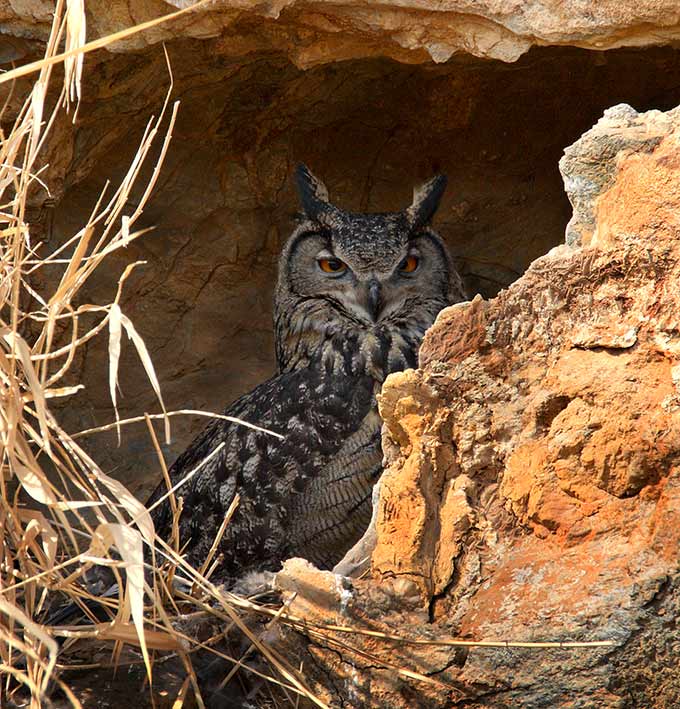
Forest and fields at Bobjeon Temple, March 19
After a rainy night a quite warm and sunny morning invited to a little trip. Beside the normal residents like Eurasian Treesparrow, Eurasian Magpie and Brown-eared Bulbul several Dusky Thrush were seen around the village close to the forest. When entering the forest the first surprise was a Common Pheasant slowly crossing the road. A little further on a flock of about 30 Brambling searched the Ground. The Great Tit, Varied Tit and Coal Tit seemed to have a singing contest and more than 10 of each were seen. Also heard and/or seen a Jay, 3 Yellow-throated Bunting and 4 Japanese Pygmy Woodpecker while 3 more distant woodpecker could be heard.
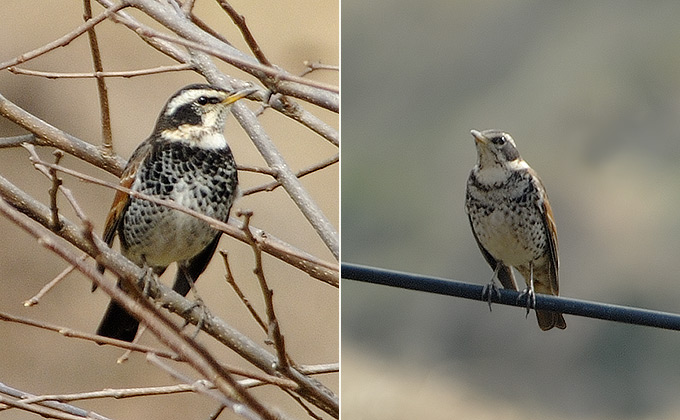

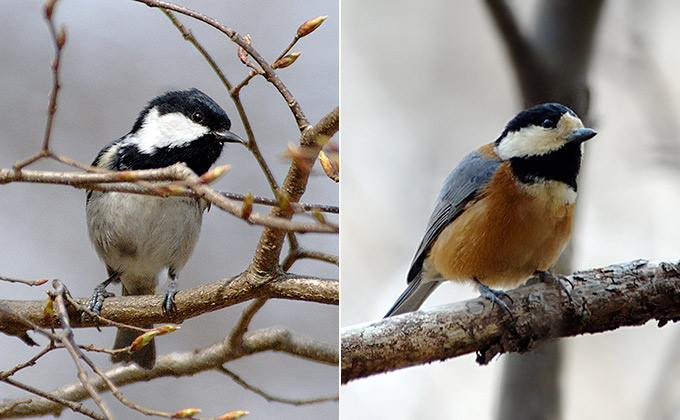
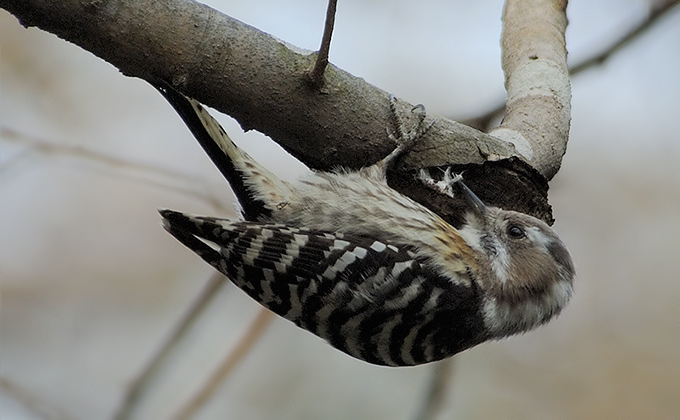
Igidae, Busan, March 17
Again very mild (possibly 18C), sunny, calm (light SE) and with good visibility. Two hours at Igidae proved very productive, with lots of singing Yellow-throated Bunting, minor Great and Coal Tits, and one group of 7 or 8 Pale Thrush. A 30 minute scan of the sea included a 3 Ancient Murrelet, one lingering Black-legged Kittiwake and a minimum 158 loons from one point. The majority of loons appeared to be Pacifics, while one very distant loon was especially eye-catching. At 60X magnification, it was clearly larger than all adjacent loons, and rather pale and brown-toned above; possessed a large and distinctly pale bill (Arctic Loon bill not visible at the same range), held angled upwards; and showed a greyish looking hind-nape with a much darker upper mantle/neck base, and rather dark neck sides, projecting into the white - all features clearly fitting Yellow-billed Loon! The last records of Yellow-billed Loon in Busan known to Birds Korea were in 1948: a series of records involving 11 or 12 individuals between March 20th and 28th reported by Fennell (and published in 1952), which suggested that the species was once a relatively numerous species here.
Joonam Reservoirs-western Nakdong Estuary, March 16
In continuing very mild (max. 16c), sunny and decidely spring-like conditions, a few hours of birdwatching together for 11 Birds Koreans. Best birds at the Joonam reservoirs were 2 Tundra Swan and c 1000+ Baikal Teal in total (many showing well), along with close views of several hundred grey geese still, and commoner woodland and edge species including Eurasian Siskin, Daurian Redstart and Long-tailed Tit, with a Spotted Redshank there an obvious indication of spring. At one spot at the Nakdong Estuary, 9 Far Eastern Curlew (while Kim Hyang-Ee reported up to 18 Little Ringed Plover, 2 Common Redshank and a Spotted Redshank at the Nakdong Estuary on 15th).
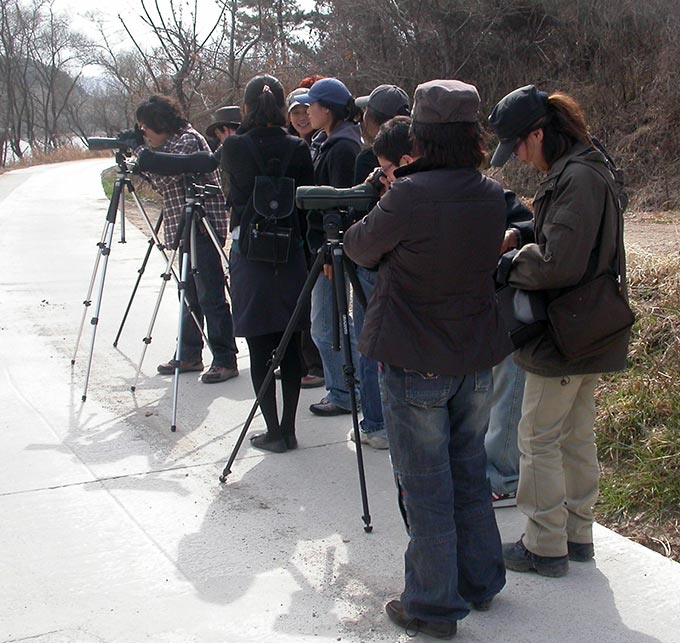
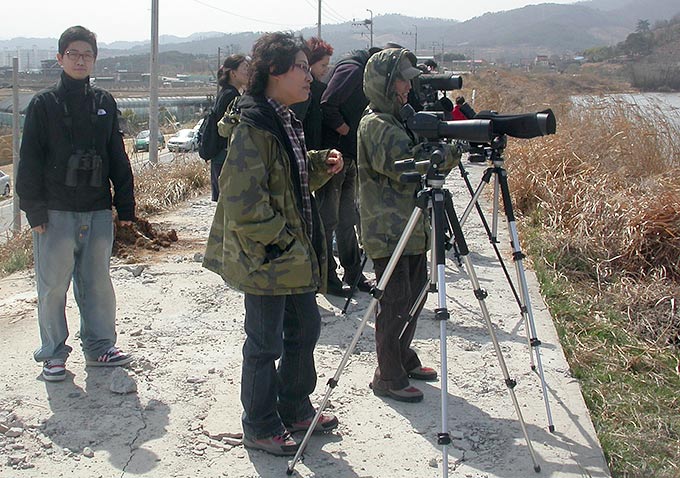
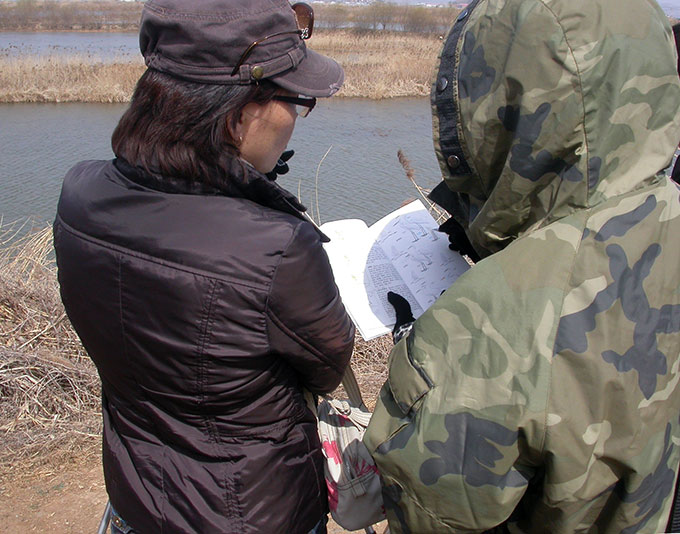
Lake Park, Ilsan, March 15, 16
A Warm and hazy morning and afternoon in Ilsan. Shortly after entering the park, a flock of 8 Chinese Grosbeak flashed by. The unexpected highlight was a Chinese Nuthatch, which hung upside down at the top of a tree for a few seconds, before flying off.
A female Pale Thrush lurked in a ditch. The resident Moorhen swam near a pair of domesticated Swan Geese.
About 50 Spotted duck, 1 Little Grebe, 5 Naumann’s Thrush, 3 Daurian Redstart were also observed over the weekend. There were flyovers on both days of several ‘V’ formations of Greater White-fronted Goose, heading away from the river. Also seen were several flocks of singing Yellow-throated Bunting, several Brown-eared Bulbul, a Great Spotted Woodpecker and some Eurasian Magpies busily gathering nesting materials. Interesting to watch was a small mixed group of Tits, including both magnus and caudatus Long-tailed Tit, as well as Great and Marsh Tit.
A prolonged attempt to re-find the Chinese Nuthatch and Chinese Grosbeak on Sunday was unsuccessful. Birds present in the park a week ago, but not seen this weekend include 6 lugens White Wagtail, several Goldcrest, and 8 Tufted duck.
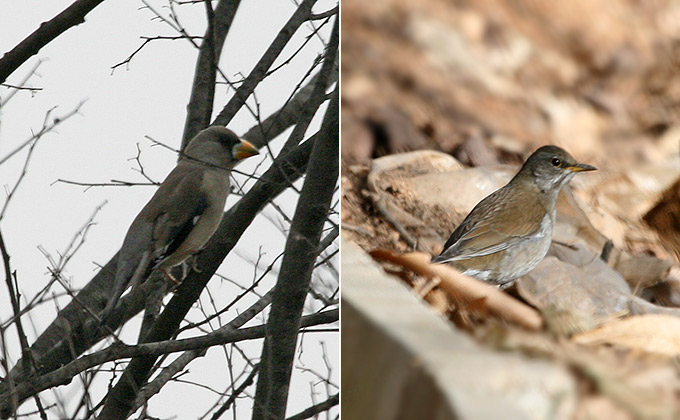
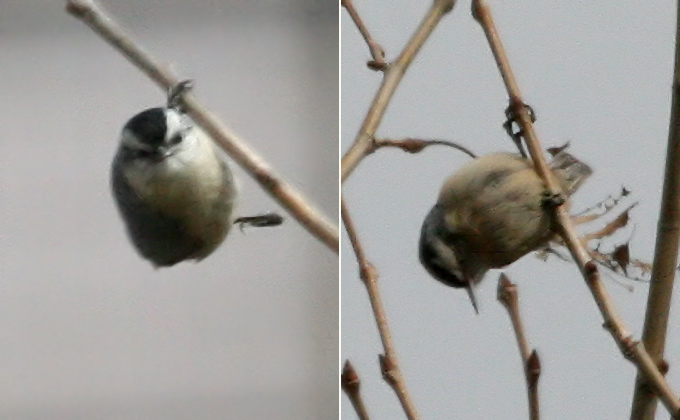
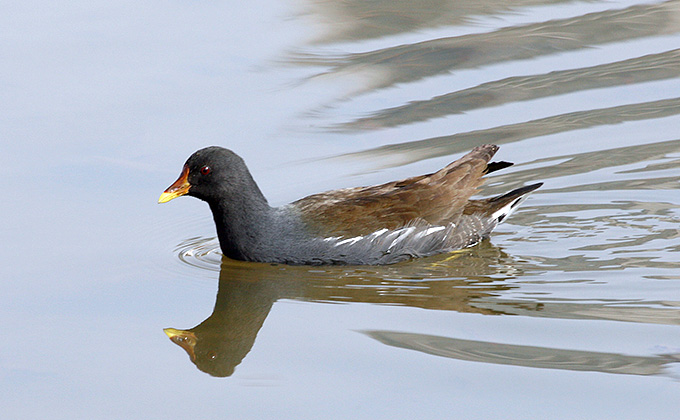
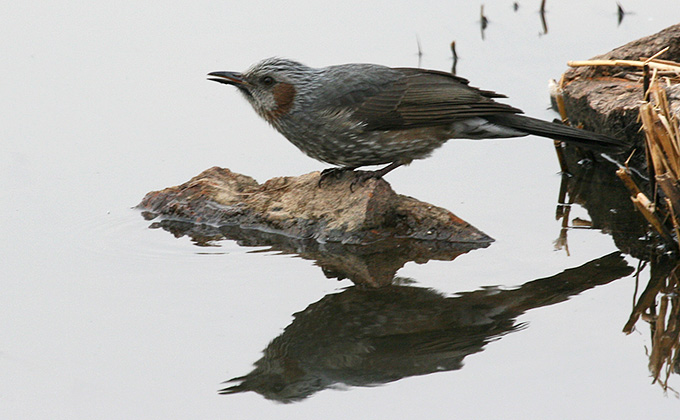
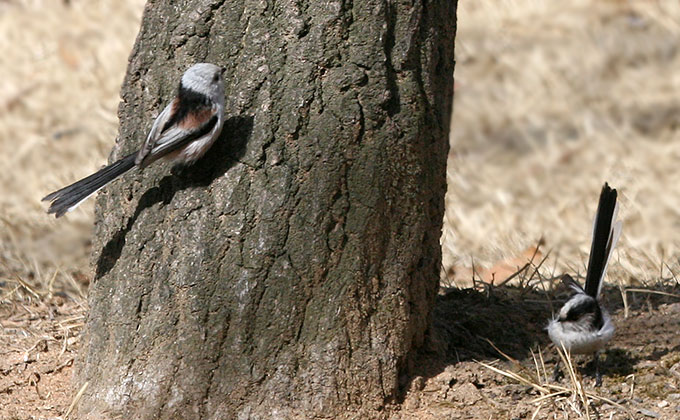
Gangwon Do coast (Okgye and Hwajin Po), March 8 & 9
A very good weekend, with some excellent species, great spring-like weather, and the chance to meet and talk birds (and their conservation of course!), for seven Bird Koreans (comprising Drs. Shim Kyu-Sik, Kim Shin-Hwan and Robin Newlin, Tim Edelsten, Barry Heinrich, Ju Yong-Gi, and Nial Moores) and one-Birds Korean for the day on 8th, Sokcho KFEM volunteer Kim Song-Mi (thanks to all for joining).
On March 8th, three or four km north of Okgye (in Jeongdongjin Ri), many hundreds of Ancient Murrelet were watched streaming south shortly after dawn by SKS, KSH, JYG and NM, with these flocks containing in less than 30 minutes of observation one Least Auklet and one Thick-billed Murre (NM only), as well as small numbers of three species of loon and both scoters.
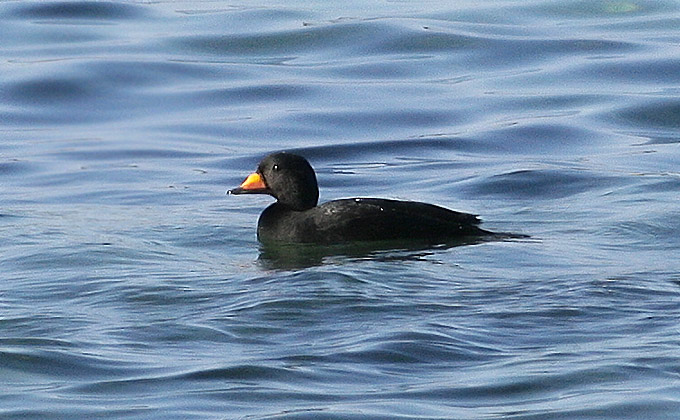
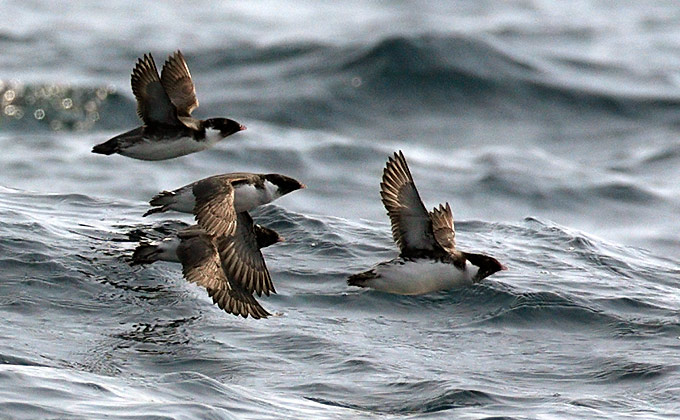
In mid-morning, en route north to Hwajin Po, hundreds of Rook and several Daurian Jackdaw were then first found by BH and KSM, along with 1500+ (possibly closer to 2500?) Greater White-fronted Goose in fields near Ganseong. Meanwhile an adult Glaucous-winged Gull at Daejin lighthouse seen by TE had disappeared from view by the time others arrived, as had two or more Harelquin Duck, the latter apparently flushed by a passing White-tailed Sea-Eagle (which was in turn later joined by another, to clash talons).
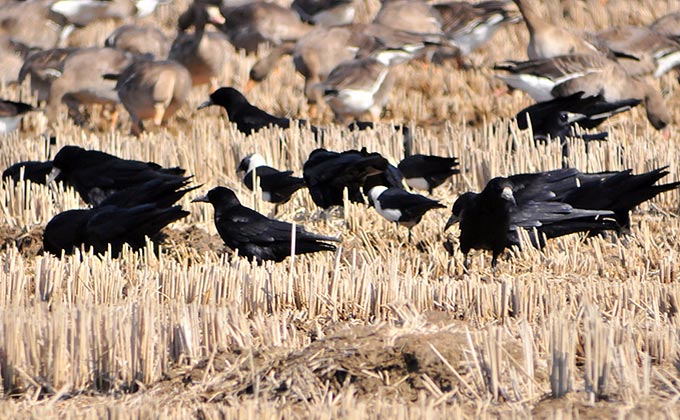
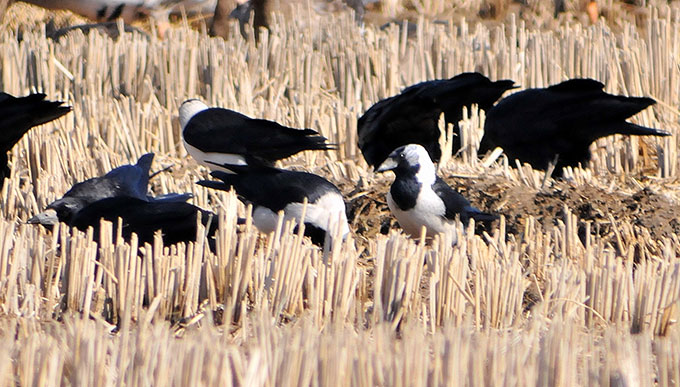
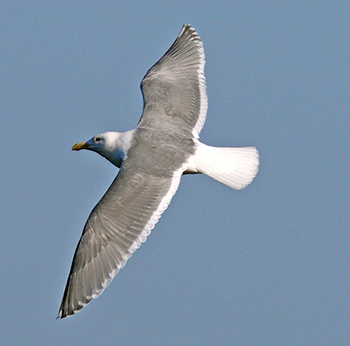
Photo © Robin Newlin
With no alcids visible from the land, the whole group finally met at the harbor, to start the much- anticipated boat trip. Twenty minutes out, and no sooner had NM called out the first (distant) breeding-plumaged Spectacled Guillemot than the boat ground to a halt, with defective steering! Towed back into harbor, the now heavy mood there was lifted considerably at the sight of a small adult white-winged-type Gull (smaller than many of the vegae that it was flying with), appearing in very strong light to be almost white-winged above, with only a faint trace of primary pattern, including an obvious white mirror on p10. After much excitement (and initial misidentification), efforts to refind the bird to better confirm its identity were successful. TE (re-)located an adult Glacous-winged Gull sitting on rocks, and seen in much better light, this was most likely the same bird that we had all watched in flight 20 minutes earlier: a very small individual, with quite a lot of wear and fading on the primaries, most obvious in flight. Three rather more typical-looking juvenile/first winters and one second-winter Glaucous-winged Gull were then also found and photographed, one in the same harbor, and three more on rocks north of Gojin, where also 5 or so Glaucous Gull, 2 Harlequin Duck and fair numbers of Red-necked Grebe (50 or so logged during the day), and Temmink's and Pelagic Cormorants.
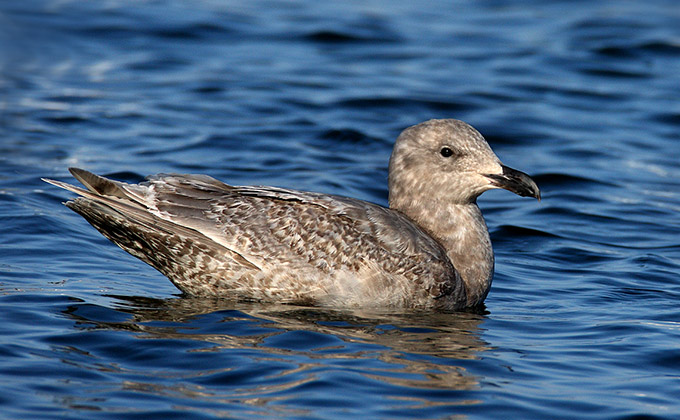
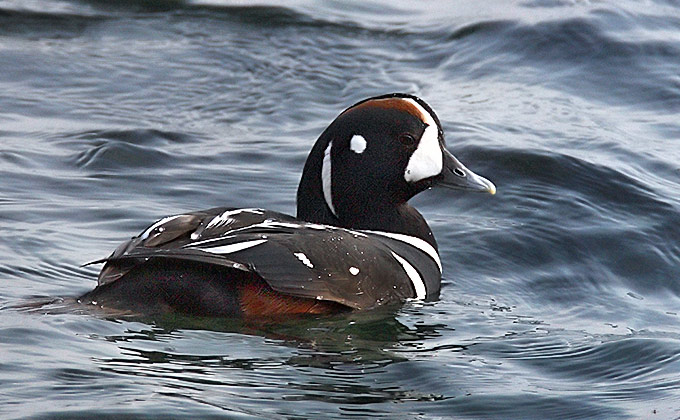
After an evening of discussion (ranging from wagtail taxonomy, the need for a complete subspecies checklist, and our preparations for the SSMP) and a good night of rest at the January Pension (as always), highlights on March 9th before the boat trip included a pair of extremely confiding (and well-photographed!) Harlequin Duck a little north of Gojin, along with a hybrid Glaucous x dark winged Gull (NM only).This time a little over three hours at sea on a mid-sized fishing boat included good views of a breeding-plumaged Horned Grebe, three other Grebe (Black-necked, Great Crested and Red-necked) and for most of the group three Loon (Red-throated, Pacific and Arctic) species, probably between 100 and 200 Ancient Murrelet (some very close, including one breeding-plumaged individual, with a very striking white head band that met broadly on the nape, easily inviting confusion with Crested Murrelet if other features had not been well seen), two Rhinoceros Auklet (both briefly), two Spectacled Guillemot (again very briefly, both in flight and neither photographed), one very probable female Long-tailed Duck (NM only) and one unidentified distant Murre (NM and RN). Bird of the weekend, first called out by RN, was however happily seen by all and photographed reasonably well from the boat by several: a breeding-plumaged Thick-billed Murre sitting on the water, at first probably at only 20 or so metres from us. While recorded several times this winter, Thick-billed Murre was first recorded in Korean waters only in 2006, and is still listed as V3 in Category One of the Birds Korea Checklist (see: http://www.birdskorea.org/Birds/Checklist/BK-CL-Checklist-info.shtml). One further highlight came somewhat later. Back at home while checking through dozens of digital images of birds taken from the boat, SKS realised that a somewhat hastily taken image yielded perhaps the biggest surprise of the day: a stunning Yellow-billed Loon!
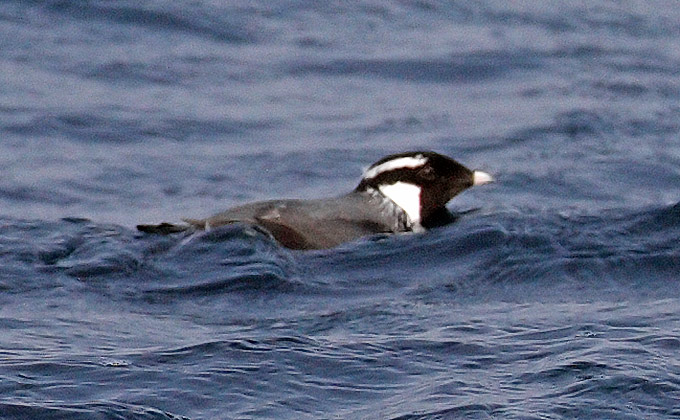
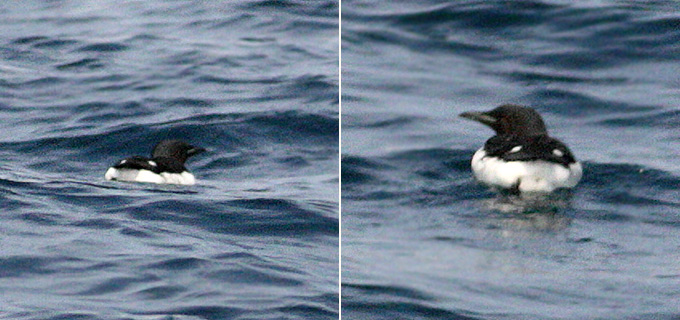
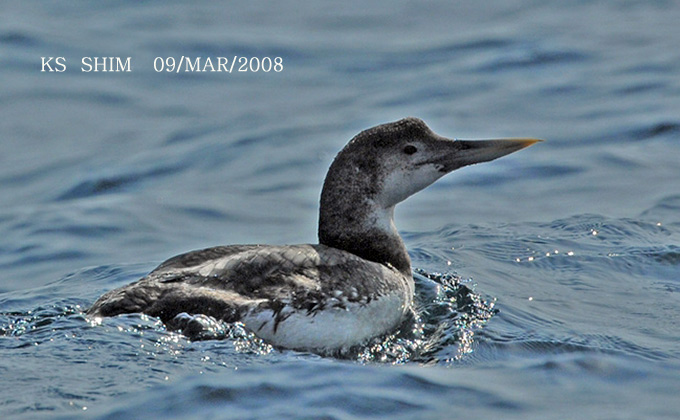
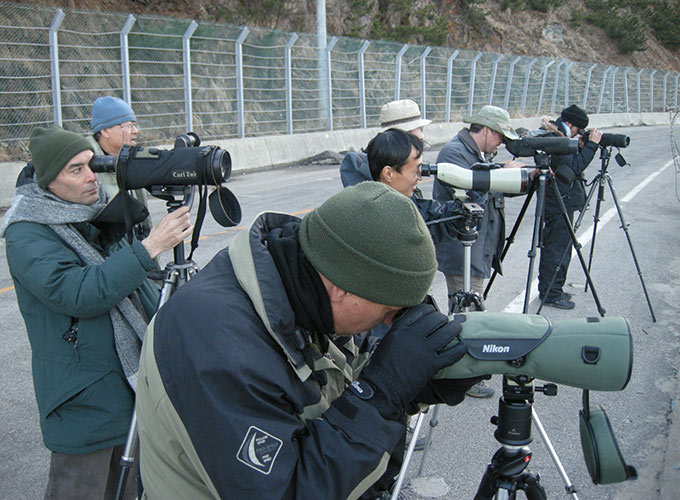
Fields and stream near Baeksok Station, Ilsan, March 8
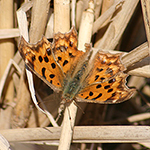
Photo © Mathew Poll
A walk through some farmer’s fields on a warm sunny day produced a sure sign of Spring: butterflies (Polygonia c-aureum). 2 Common Kestrel patrolled the fields, flushing 9 twittering Grey-Capped Greenfinch. Several inquisitive Vinous-throated Parrotbill weaved in and out of some reeds nearby. Also seen was a Grey Heron, several Great and Marsh Tit, about 30 Rufous Turtle Doves, and a pair of Common Teal. No sign of the Ruddy Shelduck from 2 weeks ago.
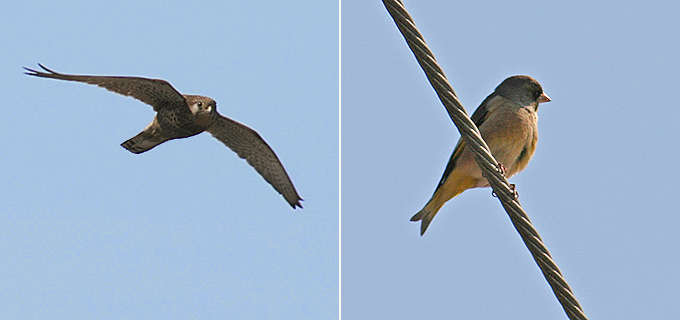
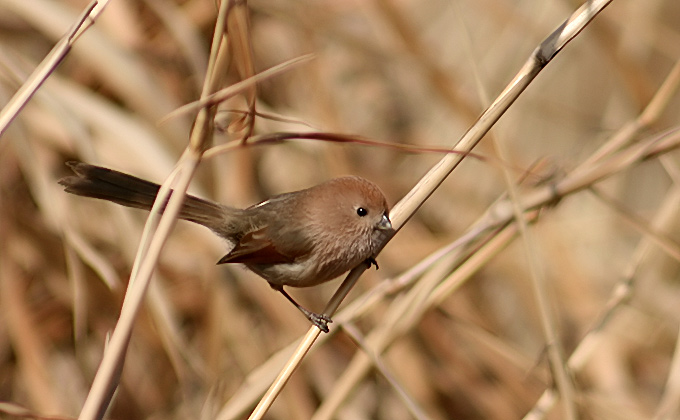
Yongsan barrage, March 7
While the number of Common Coot, Mallard, Spot-billed Duck and Gatwall were unchanged to the visit from March 3rd, some more Great Cormorant 12 and Kentish Plover 6 but less Dunlin only 19 were seen. Additionally a group of 19 Little Egret, 1 Common Merganser and 6 Great Crested Grebe from which 2 could be observed starting their courtship ritual.

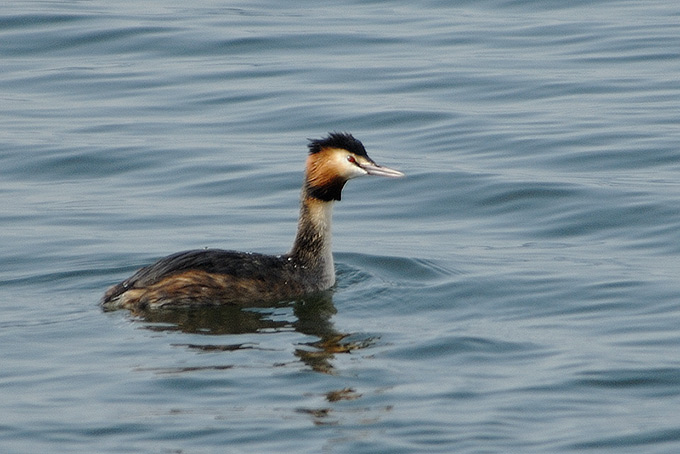
Igidae, Busan, March 6
In the afternoon 3 hours at Igidae, where the mild temperatures, large crowds of hikers and a few early migrants suggested spring is here. Along with numerous very active and vocal Varied Tit and Yellow-throated Bunting, species of most interest included 2 or 3 Pale Thrush, several flocks of Eurasian Siskin, single Carrion Crow (first personal record here) and Black Kite, 2 Ancient Murrelet, and good numbers of loons far offshore, with 65 in one group and 40 in another forming two decent-sized rafts, and a steady trickle of twos and threes, mostly moving north. The majority that were actually identified to species were Pacifics (c 15), with smaller numbers of Red-throateds (3 or 4) and at least one Arctic/Black-throated.
Yongsan barrage, March 3

Photo © Andreas Kim
A walk in the mostly sunny but windy morning on the lake side of the barrage showed 300-350 Common Coot on the water. When construction trucks passed all of the ducks which were about 150 Mallard, 60 Spot-billed Duck and 15-20 Gatwall rushed from the rocks on the side onto the water as well. A flock of 55 Dunlin also flew up, but after 2 rounds came back to rest. Also seen were 3 Kentish Plover, 4 Great Cormorant, 1 White Wagtail and 1 Buff-bellied Pipit. All the time I was accompanied by a flock of about 20 Treesparrow which restlessly followed between the bushes. On the way back I also collected 8 dead Mallard which all had served as a good meal.
